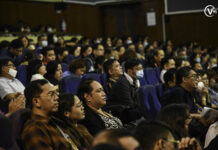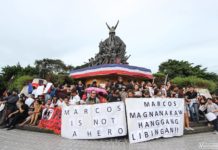DR. AURORA Parong could still remember when his brother became a casualty of Martial Law.
A graduate of the University of the Philippines College of Law, Aurora’s brother opted to go to provinces and take cases fighting police brutality.
One night, he simply vanished into the dark. “We just came to know that he left the house and did not come back for the night,” Aurora told the Varsitarian. “In the morning, we were informed of a person who was found on the highway, and I identified him as my brother at the funeral parlor. There was no justice at the time.”
Justice would also be elusive for Aurora when she was imprisoned for nearly two years after constables claimed she treated a rebel in her private clinic.
“I don’t even ask my patients what their political position is or anything,” she recalled. “Even if I don’t like this political party, I don’t consider them enemies. But I have to do my work as a medical doctor.”
“They charged me with inciting rebellion. Although I did not have any warrant of arrest when they arrested me, a presidential commitment order signed by Marcos made me stay in detention for one and a half years. The charges were later dismissed sometime in 1986.”
Parong later helped lead the Philippine chapter of the human rights group Amnesty International, which recorded more than 70,000 imprisonments, 34,000 cases of torture and 3,000 deaths during Martial Law.
Former president Ferdinand Marcos Sr. affixed his signature on Proclamation 1081 on the night of Sept. 21, 1972, placing the Philippines under Martial Law to repel communist forces allegedly undertaking rebellious acts against the government.
But the president cloaked the real intention of Martial Law when he announced it in a televised address on Sept. 23 by assuring “it is not a military takeover of civilian functions.”
In the following weeks, months and years, it was clear that state forces were hunting for perceived government critics, regardless of their age or class, to curtail dissent.
“The killings happened to silence protests,” former Akbayan partylist representative Tom Villarin told the Varsitarian. “We had the MetroCom (Metropolitan Command) and they had a lot of intelligence agents even inside the campuses.”
“As students, our reaction was really to protest. That’s why weekly, we have to rally to bring attention, especially to the international community, about these killings.”
‘Tear gas for breakfast’
Warrants of arrest at the time came in the form of arrest, search and seizure orders (ASSO), detaining individuals who were “active participants in the conspiracy to seize political and state power in the country,” as per General Order 2 signed on Sept. 22, 1972. In 1977, General Order 60 limited ASSO to offenses under military tribunals’ jurisdiction.
But in 1983, claiming that some elements “persist in endeavoring to overthrow the government by violent means,” Marcos issued Presidential Decree 1877 authorizing the military to arrest anyone actively involved in insurrection or rebellion even before obtaining a warrant.
Multi-awarded filmmaker and writer Jim Libiran told the Varsitarian that protesters knew from the get-go what was at stake as they prepared themselves for retaliation by state forces.
“Ready ka lagi sa violence dahil ang tawag nga namin do’n, ‘tear gas for breakfast,’” Libiran, a sociology alumnus, said. “Nasubukan niyo na ba ‘yung pepper spray, tear gas? Laging ‘yon ang sumasalubong sa amin sa [rallies].”
(You should be ready for any violence—we call it “tear gas for breakfast.” Have you ever been pepper sprayed or sprayed with tear gas? That’s what the police greet us with during rallies.)
Lawyer Jay de Castro paid a hefty price for leading the Fraternal Organization of the University of Santo Tomas (FROUST), a union of Metro Manila-based fraternities advocating for student rights.
Philippine Navy forces dragged him from his psychology class on Sept. 6, 1976, in an apparent abduction inside the UST campus. However, their attempt was thwarted by fellow students and Herminigildo Ramos, who was the coordinator for student affairs from 1970 to 1986.
When that didn’t work, military men tried to stab De Castro and his fellow fratmen. “All the while, akala ko tinamaan siya, nasaksak siya, kasi bumagsak eh […] Mabuti na lang meron siyang rosary. So may butas ‘yon. Then when I looked at my barong, hiwa-hiwa na [siya],” he told the Varsitarian.
(All the while, I thought my friend was stabbed because he fell on the ground. Thank God he had a rosary, and it had holes. Then, when I looked at my barong, it was already ripped.)
Worse, he was sued for frustrated murder for allegedly leading a rumble that hurt a student whose relatives were in the upper echelons of the military.
“Parang walang hope e ‘no,” De Castro, a former deputy director general at the Bureau of Corrections, said. “Of course, our hope was ourselves. Despite all of these sad, horrible experiences, I still pursued my studies. Nagtuloy pa rin ako under that atmosphere.”
(You would feel hopeless. Of course, our hope was ourselves. Despite all of these sad, horrible experiences, I still pursued my studies. I persisted despite being under that atmosphere.)
Even faculty members during Martial Law became targets of prosecution. Such was the case of Carmelito Tatlonghari, an instructor at the Faculty of Engineering from 1974 to 1976 and Faculty of Pharmacy from 2002 to 2003, who suffered an eight-month jail time for adopting a homeless family that state forces claimed to be “terrorists.”
“I was incarcerated at the Bicutan Rehabilitation Center for eight months. It’s really a waste of time being inside prison, being a political prisoner,” he told the Varsitarian. “But I was proud of that because I was able to stand in my belief, doing good works, you know, the corporal works of mercy, of sheltering the homeless.”
‘Advocates of radical democracy’
Survivors are relying on today’s youth to prevent the country from forgetting the atrocities of Martial Law.
“[I]t is important for the youth to always remember history; it is always important to look back in the past, take all the learnings in the past, and improve on what was given to them because when you just repeat history, you won’t move forward,” Villarin, an economics alumnus, said.
Retaining Martial Law from the national consciousness has become a daunting task even though the country annually commemorates the People Power Revolution, which marked the downfall of Marcos’s dictatorship, every Feb. 25, and Ninoy Aquino Day every Aug. 21 to commemorate the death of the senator which galvanized the nation in rallying against the president.
In a 2016 Social Weather Stations (SWS) survey, 44 percent of Filipinos agreed there was much oppression done to Filipinos from 1972 to 1986, compared to 30 percent who disagreed.
But support for the Marcoses grew over time since former president Corazon Aquino allowed the family to return to the country in 1991. Two months after Marcos’s ouster, 51 percent of Filipinos thought the late dictator plundered government funds. However, a 2003 poll showed that 54 percent were open to granting amnesty to the Marcoses in the name of reconciliation and unity.
In 2022, Ferdinand “Bongbong” Marcos Jr. achieved a significant milestone when he secured the presidency. According to Jonathan Ong, an associate professor at the University of Massachusetts specializing in global digital media, this victory was the result of a deliberate, long-standing effort to improve their public image on social media and strategic alliances with the influential Dutertes, all aimed at rallying support against their perceived “liberal elite” adversaries.
The trick worked among Generation Zs: In Pulse Asia’s last survey before the May 9, 2022 polls, more than 70 percent of respondents aged 18 to 24 preferred Marcos over her archrival, former vice president Leni Robredo, to be president.
Tatlonghari said students and the academe must remain “vigilant” to avoid repeating history.
“If it is in their DNA to be a dictator, then I think we have to do concrete actions in order to prevent that kind of path or that kind of development in our political, social and economic system going back to Martial Law because I think it really destroyed the very essence of democracy,” he said.
Survivors added that young people must stop being indifferent to sociopolitical affairs and instead take up the cudgels to be “advocates for radical democracy.”
“It’s always the youth who are the beacons of hope, to be the innovators and advocates for radical democracy. That’s part of the DNA of the youth,” Villarin said.
“The youth should not lose hope because once the youth lose hope, the country loses hope.” Eduardo G. Fajermo Jr. and Ralent M. Penilla with reports from Chalssea Kate C. Echegoyen and Hannah Joyce V. Andaya




















